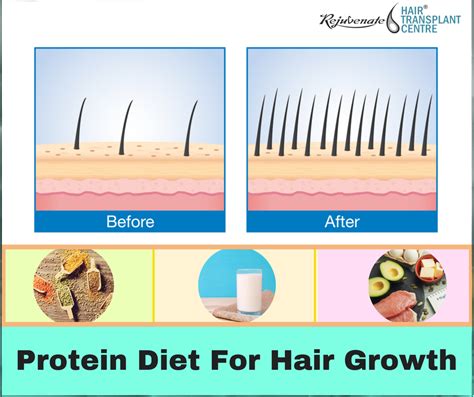What is Protein and Why is it Important for Hair?
Protein, a crucial building block of hair, is essential for maintaining its strength, elasticity, and overall health. It comprises keratin, a fibrous protein providing hair with its structure and resilience. When hair lacks sufficient protein, it becomes prone to breakage, dryness, and dullness.

Signs of Protein Deficiency in Hair
How can you detect protein deficiency in your hair? Here are a few telltale signs:
- Breaking and fraying hair strands
- Frizz, tangles, and unmanageable texture
- Dry, brittle strands with a lack of shine
- Hair shaft that snaps off easily in the middle
The Benefits of Protein Hair Treatments
Incorporating protein treatments into your hair care regimen offers numerous benefits:
- Repairs damaged hair by filling in weakened areas
- Restores strength and elasticity, preventing breakage
- Adds shine and smoothness, enhancing hair’s overall appearance
- Protects hair from future damage caused by heat styling, chemical treatments, and environmental stressors
- Promotes thicker, fuller-looking hair
Types of Protein Hair Treatments
Several types of protein hair treatments are available, catering to specific hair needs:
1. Keratin Treatments
Keratin treatments work by infusing hydrolyzed keratin protein into the hair shaft, repairing damage and restoring smoothness. They offer long-lasting results (up to six months) while reducing frizz and improving manageability.
2. Protein Masks
Protein masks are deep conditioning treatments that provide a concentrated dose of protein to strengthen and repair damaged hair. They come in various formulations, including leave-in and wash-out masks.
3. Protein Sprays
Protein sprays are lightweight treatments that deliver a quick boost of protein to hair. They can be applied to dry or damp hair for instant conditioning and repair.
How Often Should You Use Protein Hair Treatments?
The frequency of protein hair treatments depends on the condition of your hair. Damaged or chemically-treated hair may require weekly treatments, while healthy hair may benefit from monthly applications. Overuse of protein treatments can lead to protein overload, causing hair to become brittle and susceptible to breakage.
Tips for Choosing the Right Protein Hair Treatment
When selecting a protein hair treatment, consider your hair type and damage level.
- Fine or damaged hair: Choose mild protein treatments that gently restore strength without weighing it down.
- Thick or coarse hair: Opt for stronger protein treatments that provide deep conditioning and repair.
- If you have chemically-treated or heat-styled hair: Use protein treatments that protect hair from further damage and restore its health.
Protein-Rich Foods for Healthy Hair
In addition to topical protein treatments, incorporating protein-rich foods into your diet supports healthy hair growth from within. Here are some excellent sources of protein:
- Lean meats (chicken, fish, turkey)
- Eggs
- Dairy products (milk, yogurt, cheese)
- Beans and lentils
- Nuts and seeds
- Whole grains
Table 1: Comparison of Protein Hair Treatment Types
| Treatment Type | Benefits | Duration | Suitable for |
|---|---|---|---|
| Keratin Treatment | Repairs damage, reduces frizz, enhances shine | 4-6 months | Damaged or chemically-treated hair |
| Protein Mask | Deeply conditions, strengthens hair, improves manageability | 15-30 minutes | All hair types |
| Protein Spray | Instant conditioning, repairs damaged strands | 2-3 times per week | All hair types |
Table 2: Protein-Rich Foods for Healthy Hair
| Food | Protein Content (per 100g) |
|---|---|
| Chicken breast | 31g |
| Eggs | 13g |
| Salmon | 22g |
| Greek yogurt | 10g |
| Almonds | 21g |
| Quinoa | 14g |
Table 3: DIY Protein Hair Mask Recipes
| Ingredients | Instructions |
|---|---|
| Egg yolk | Beat the yolk and apply it to your hair. Cover with a shower cap and leave it on for 20 minutes. Rinse thoroughly. |
| Yogurt mask | Mix 1 cup of plain yogurt with 2 tablespoons of honey. Apply the mixture to your hair and let it sit for 30 minutes. Rinse it with warm water. |
| Banana mask | Mash one ripe banana and add 1 tablespoon of olive oil. Apply the paste to your hair and leave it on for 15 minutes before rinsing it off. |
Table 4: Frequently Asked Questions about Protein for Hair
| Question | Answer |
|---|---|
| How do I know if my hair needs protein? | Signs of protein deficiency include breakage, dryness, dullness, and easy snapping of hair. |
| Can I use protein hair treatments on color-treated hair? | Yes, but use them cautiously as they may strip the color over time. |
| How often should I wash my hair after a protein treatment? | Wait at least 2-3 days after a protein treatment to wash your hair. |
| Can I use a protein hair mask on the scalp? | Yes, but avoid the roots to prevent scalp irritation. |
| What is “protein overload” and how do I avoid it? | Protein overload occurs when you overuse protein treatments, leading to brittle and breakage-prone hair. Use protein treatments in moderation. |
Conclusion
Protein is a vital nutrient for healthy, vibrant hair. By incorporating protein-rich foods into your diet and using appropriate protein hair treatments, you can restore damaged hair, improve its strength and elasticity, and enhance its overall appearance. Listen to your hair’s cues, experiment with different protein treatments, and create a customized hair care regimen to achieve the locks you desire.
